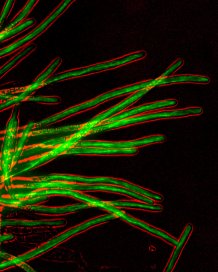
Professor Steinberg and his colleagues have investigated how cells undertake long range transport within polarised cells
New insight into the transport systems of cells
New insights into the basic operation of cells has been revealed in ground-breaking research carried out at the University of Exeter using a combination of advanced live-cell imaging, molecular genetics and quantitative analysis.
Research led by Gero Steinberg, Professor of Cell Biology and Director of the Bioimaging Centre at the University of Exeter, features in both the latest editions of the Journal of Cell Biology.
Professor Steinberg and his colleagues have investigated how cells undertake long range transport within polarised cells, such as those in the nervous system of humans. Speaking about the research, Professor Steinberg said “ We want to understand how cells can transport and distribute cargo within cells. This is vital if we are to understand how nerve cells operate, for instance, or how pathogenic fungi are able to cause diseases".
Cells have transport networks composed of long microtubules that act like motorways for long distance transport, which uses special motor proteins to delivery cargo to different parts of cells, such as the nucleus, organelles, or for secretion outside of a cell. Prof. Steinberg has used the model fungus Ustilago mayidis to identify the how motor proteins are regulated so they can carry out transport in opposite directions along microtubules.
In the latest article, the researchers found that a special protein called ‘Hook’ controls the attachment of two different motors, dynein and kinesin-3, to cargo, thereby controlling the transport direction of the organelles. Hook proteins have previously been implicated in numerous human diseases, but the reason for this was unknown. The Exeter research now reveals why they are so important in the operation of neurons and cells within the brain.
Speaking about the research, Professor Nick Talbot, Deputy Vice-Chancellor for Research said: “This research is impressive because it integrates the latest advances in bio-imaging so we can look at the operation of motor proteins in living cells in un-paralleled detail. Prof. Steinberg’s group then collaborate with mathematicians to model the movement and activity of these motors and their key regulators, such as Hook. It is this combination of skills which allows such important and fundamental new discoveries to be made.”
The authors, including Postdoctoral Fellows Dr Yujiro Higuchi and Dr Ewa Bielska carried out the detailed microscopy and image analysis collaborating with mathematical modeller Professor Peter Ashwin from the Department of Mathematics. The research is highlighted by the Journal as a key breakthrough (Ben Short, J Cell Biol, 2014 , 204:859)and featured also in their podcast of new discoveries (http://jcb.rupress.org/content/204/3/343/suppl/DC2).
- Higuchi, Y., Ashwin, P., Roger, Y., Steinberg, G. (2014) Early endosome motility spatially organizes polysome distribution. J. Cell Biol., 204, 343-357.
- Bielska, E., Schuster, M., Roger, Berepiki, A., Y., Soanes, D., Talbot, N.J., Steinberg, G. (2014) Hook is an adapter that coordinates kinesin-3 and dynein cargo-attachment on early endosomes. J. Cell Biol., 204,989-1007.
Date: 20 March 2014
